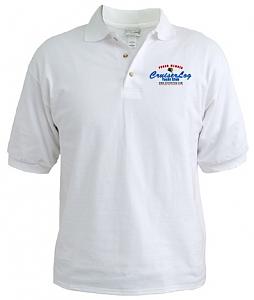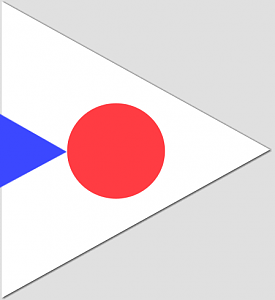 |
|
 12-18-2007, 09:17 PM
12-18-2007, 09:17 PM
|
#1
|
|
Rear Admiral
Join Date: Sep 2007
Posts: 396
|
I was wondering if anyone has submitted a design? If not, or one has not been chosen then how about this...CYC with the first C reversed...simple, and symetrical
__________________
__________________
|

|

|
 12-19-2007, 01:42 AM
12-19-2007, 01:42 AM
|
#2
|
|
Admiral
Join Date: Oct 2004
Posts: 3,067
|
Quote:
Originally Posted by imagine2frolic

I was wondering if anyone has submitted a design? If not, or one has not been chosen then how about this...CYC with the first C reversed...simple, and symetrical
|
Like this ƆYC ??
But who for ??
__________________
__________________

|

|

|
 12-19-2007, 01:23 PM
12-19-2007, 01:23 PM
|
#3
|
|
Rear Admiral
Join Date: Sep 2007
Posts: 396
|
The club here asked for thoughts on a design, and that just popped into my empty head.....LOLOLOLOL
__________________
|

|

|
 01-24-2008, 05:44 PM
01-24-2008, 05:44 PM
|
#4
|
|
Ensign
Join Date: Dec 2007
Posts: 21
|
Quote:
Originally Posted by imagine2frolic

The club here asked for thoughts on a design, and that just popped into my empty head.....LOLOLOLOL
|
I love to draw and I thought about this....See attached. burgee.pdf
__________________
|

|

|
 01-24-2008, 06:23 PM
01-24-2008, 06:23 PM
|
#5
|
|
Retired Mod
Join Date: Mar 2007
Home Port: Durban
Posts: 2,984
|
@tugtyee
That's great. One problem though.
Ideally, a burgee should have a "mirror" image on the back side because of print "bleed" through the fabric. The alternative is to have double fabric sewn together with the obvious cost implication.
Don't forget the CruiserLog decals HERE in the meantime.
 : Most sections |

|

|
 01-25-2008, 11:59 AM
01-25-2008, 11:59 AM
|
#6
|
|
Rear Admiral
Join Date: Sep 2007
Posts: 396
|
This is what I had in mind....I am no artist....LOLOLOLOL
__________________
|

|

|
 01-25-2008, 03:07 PM
01-25-2008, 03:07 PM
|
#7
|
|
Ensign
Join Date: Dec 2007
Posts: 21
|
Quote:
Originally Posted by Lighthouse

@tugtyee
That's great. One problem though.
Ideally, a burgee should have a "mirror" image on the back side because of print "bleed" through the fabric. The alternative is to have double fabric sewn together with the obvious cost implication.
Don't forget the CruiserLog decals HERE in the meantime. |
 yes you are absolutly right about that ,but we got a few more minds on it now ..Hope that brings in some more ideas.
best regards..
Denny
__________________
|

|

|
 05-03-2008, 05:18 PM
05-03-2008, 05:18 PM
|
#8
|
|
Ensign
Join Date: Apr 2007
Posts: 19
|
I am absolutely atrocious at drawing but may I suggest the following:
a - Tugtyee's burgee has much merit but it is not a burgee - it is a pennant. A burgee is a flag with two tails if I remember my seamanship lessons correctly
b - I am of the opinion that a true burgee (two-tailed) looks better than a pennant, but that is just a matter of taste
c - For a design I would suggest, from let to right, a C with a globe in the centre followed by a similar be reversed C and the other half of the globe in its centre, both of which supported by the arms of a Y.
I would like to be able to provide a template but, as I mentioned, my artistic skills are stone-age.
James Lidstone-Collingwood
__________________
|

|

|
 05-03-2008, 11:25 PM
05-03-2008, 11:25 PM
|
#9
|
|
Admiral
Join Date: Oct 2004
Posts: 3,067
|

Quote:
Originally Posted by Collingwood

a - Tugtyee's burgee has much merit but it is not a burgee - it is a pennant. A burgee is a flag with two tails if I remember my seamanship lessons correctly
b - I am of the opinion that a true burgee (two-tailed) looks better than a pennant, but that is just a matter of taste
|
Yacht club burgee
Members belonging to a yacht club or sailing organization may fly their club's unique triangular burgee both while underway and at anchor (however, not while racing). Traditionally, the burgee was flown from the main masthead, however it may also be flown from a small pole on the bow pulpit, or even the starboard rigging beneath the lowest starboard spreader on a flag halyard.
Traditionally, the first time a member of one club visits another, there is an exchange of burgees. Exchanged burgees are then often displayed on the premise of each, such as at a club office or bar.
-------------------------------
Pennant
Or historically called a pennon, is a long narrow flag which conveys different meanings depending on its design and use. Specific pennants might include:
* A commissioning pennant, or masthead, which a warship flies from its masthead and indicates the commission of the captain of the ship (and thus of the ship itself). In the Royal Navy, the commissioning pennant is a small St George's Cross with a long tapering plain white fly. In the United States Navy, it is red above white, with seven white stars in the blue hoist. The commissioning pennant may be displaced by various rank flags, namely the flags or pennants of admirals or commodores, and the personal flags of heads of state and members of royal families.
* A church pennant, as used by the Royal Navy, European Navies and Commonwealth Navies, is a broad pennant flown on ships and at establishments (bases) during religious services, and has the George Cross and Dutch flag incorporated chosen after the English Dutch Wars where both sides stopped for Church on a Sunday.
* A Senior Officer Present Afloat pennant using the NATO signal flag for "Starboard" is green on the hoist and fly with a white field between.
* A Gin Pennant means that the wardroom is inviting officers from ships in company to drinks. The origins of the Gin Pennant are uncertain, but it seems to have been used since the 1940s and probably earlier. Originally it was a small green triangular pennant measuring approximately 18 inches by 9 inches (460 by 230 mm), defaced with a white wine glass, nowadays the gin pennant is a Starboard pennant defaced with a wine or cocktail glass. Its colour, size and position when hoisted were all significant as the aim was for the pennant to be as inconspicuous as possible, thereby having fewer ships sight it and subsequently accept the invitation for drinks.The Gin Pennant is still in regular use by the Royal Australian Navy (RAN). Within the RAN it is common practice, whilst in port, for junior officers of one ship to attempt to raise the Gin Pennant on the halyard of another ship, thereby forcing that ship to put on free drinks for the officers of the ship that managed to raise the pennant. If, however the junior officers are caught raising the pennant, then it is their ship that must put on free drinks within their Wardroom. Usually this practice is restricted to Commonwealth Navies, however in the past, prior to increased force protection, RAN officers have successfully raised the Gin Pennant on a number of units in the USN
Maritime flags
__________________

|

|

|
 11-14-2008, 07:56 AM
11-14-2008, 07:56 AM
|
#10
|
|
Rear Admiral
Join Date: Sep 2005
Posts: 349
|
I think this is worth lots more thought.
At the risk of sounding really old fashioned, I much prefer club burgees that don't have initials or even words on them. Just a somewhat unique but simple design.
Blue and white are clearly good colours to consider.
Or if a burgee was simply two panels then most 'members' could even improvise and make their own.
Or maybe even just code flag 1 - indicating the best on the web?
I once belonged to Perth Flying Squadron and Fremantle Sailing Club. Neither origins obvious from the respective designs - but is was always good when others asked 'whats that little flag mean then?'
Cheers
JOHN
|

|

|
 11-21-2008, 01:37 PM
11-21-2008, 01:37 PM
|
#11
|
|
Rear Admiral
Join Date: Sep 2005
Posts: 349
|

Hi All,
I see all has gone quiet since a week back...........
The examples I gave above for Freo Sailing Club - a white ball on a blue field, and Perth Flying Squadron - a gold St Johns cross on a black field are equally as stylistic as say maritime code flag 1..........
So what's the view on us just picking Code Flag 1 - which is a red ball on a white field?
At this time it would signify our club is No 1.
To my knowledge no one else is using it as a club flag.
No one needs spend time originating a new design.
The simplicity means it will never get dated.
Most of us would have such a signal flag on board.....
So no expense.........
And no distribution issues either.
The examples I gave above for Freo Sailing Club - a white ball on a blue field, and Perth Flying Squadron - a gold St Johns cross on a black field are good guidelines that a simple design can stand the test of time.
So what do you all think? Please feel free to be as critical if you want........but if this was decided we could see little Cruiserlog Burgees being hoisted inside days at various spots around the globe.
JOHN
|

|

|
 11-23-2008, 08:57 AM
11-23-2008, 08:57 AM
|
#12
|
|
Retired Mod
Join Date: Mar 2007
Home Port: Durban
Posts: 2,984
|

It would be great to have a CruiserLog burgee. Unfortunately, they work out pretty expensive with artwork charges and minimum order quantities. These would then have to be held at a central repository to handle individual orders, payments and deliveries - a logistical nightmare for a "virtual" Yacht Club.
However, our decals have proved popular and are of good quality - and inexpensive! No minimum orders - fast delivery worldwide and secure online payment - PERFECT! Just order quickly online!
Proudly display it on your boat and be recognised as a CruiserLog member.
Our decals are printed on durable 4mil vinyl using water and UV resistant inks – meaning no fading in the sun or bleeding in the rain.
Measures 3" x 5" (rectangle or oval)

See all the CruiserLog gear HERE - such as shirts, t-shirts, caps, coffee mugs, beer tankards, etc.
Some examples: ( Golf-shirt and shore-bag)

Also for crew:

Let us know how you like them. The feedback we have had is that the quality is great and the delivery fast (even as far as to Australia).
.
 : Most sections |

|

|
 11-23-2008, 03:07 PM
11-23-2008, 03:07 PM
|
#13
|
|
Rear Admiral
Join Date: Sep 2005
Posts: 349
|
Quote:
Originally Posted by Lighthouse

It would be great to have a CruiserLog burgee. Unfortunately, they work out pretty expensive with artwork charges and minimum order quantities. These would then have to be held at a central repository to handle individual orders, payments and deliveries - a logistical nightmare for a "virtual" Yacht Club.
|
EXACTLY. Good reason to adopt the code flag 1 as our club burgee. No?
JOHN
|

|

|
 11-23-2008, 03:12 PM
11-23-2008, 03:12 PM
|
#14
|
|
Retired Mod
Join Date: Mar 2007
Home Port: Durban
Posts: 2,984
|
Hi John
How does one relate it to CruiserLog? You would just be flying the Number one.
 : Most sections |

|

|
 11-24-2008, 01:20 PM
11-24-2008, 01:20 PM
|
#15
|
|
Rear Admiral
Join Date: Sep 2005
Posts: 349
|
For me it could mean the number one virtual yacht club on the web.........
Fremantle Sailing Club is a white orb on a dark blue field and I am still unsure why they chose that.
And indeed some might say their members are flying Number two.
But it is a burgee flown with pride by thousands of members. And one I've seen hanging in many other clubs where it's been presented and accepted with pride.
So if artwork, distribution and costs are whats stopping us flying a burgee, does it not make sense to take a leaf out of other more established clubs books? I personally dislike burgees that have words or initial on them - much better in my view if they are clear and distinctive. A red orb on a white field is not to my knowledge used yet by any other yacht club - and in that respect it is unique.
Case presented. It is only an idea which I hope has sufficient going for it to be adopted. No anxst on my part if its not.
Cheers
JOHN
|

|

|
 11-24-2008, 02:07 PM
11-24-2008, 02:07 PM
|
#16
|
|
Admiral
Join Date: Sep 2005
Posts: 1,619
|
An alternative could be to design a burgee that is easily made by our members themselves. Let's face it, making a Brazilian flag might prove a bit of a headache but a simple burgess should be within the capabilities of most cruisers. We could even start with a standard code flag, say flag B or X but not a more complex one such as W, and add an appropriate symbol. The template for the symbol could be made available here and all the individual member would need to do would be to scale it up or down as apropriate, pin it to bunting of the right colour and cut it out before sewing it to the code flag.
I suggest second substitute, as blue and white are our colours, and adding the letters CL, in white close to the hoist.
What does the team think?
Aye // Stephen
|

|

|
 11-24-2008, 02:19 PM
11-24-2008, 02:19 PM
|
#17
|
|
Retired Mod
Join Date: Mar 2007
Home Port: Durban
Posts: 2,984
|
So, a Number one flag is very cheap.
A blue waterproof marker is dirt cheap (you probably have one aboard). Or, a small pot of blue waterproof fabric paint.
A suggestion - to change it (easily) from the official nautical No 1 flag:

No longer the Nautical number one but now - " CruiserLog, The number one Virtual Yacht Club"
Comments?
 : Most sections |

|

|
 11-24-2008, 04:34 PM
11-24-2008, 04:34 PM
|
#18
|
|
Rear Admiral
Join Date: Sep 2005
Posts: 349
|
Brilliant.
You've one vote from me.
Unique, no 1, simple classic design. Ticks all my boxes.
JOHN
|

|

|
 11-24-2008, 10:31 PM
11-24-2008, 10:31 PM
|
#19
|
|
Admiral
Join Date: Oct 2004
Posts: 3,067
|
Red Ball on White Backround ? Why choose a a flag that may be taken to show Japanese connections on the boat ?
__________________

|

|

|
 11-25-2008, 01:46 PM
11-25-2008, 01:46 PM
|
#20
|
|
Rear Admiral
Join Date: Sep 2005
Posts: 349
|
Quote:
Originally Posted by MMNETSEA

Red Ball on White Backround ? Why choose a a flag that may be taken to show Japanese connections on the boat ?
|
Serious?
On that basis maybe we should all stop using this little chappie - 
JOHN
__________________
|

|

|
 |
|
|
Currently Active Users Viewing This Thread: 1 (0 members and 1 guests)
|
|
|
 Posting Rules
Posting Rules
|
You may not post new threads
You may not post replies
You may not post attachments
You may not edit your posts
HTML code is Off
|
|
|
 Similar Threads
Similar Threads
|
| Thread |
Thread Starter |
Forum |
Replies |
Last Post |
|
Fly The Burgee!
|
Lighthouse |
General Cruising Forum |
1 |
12-28-2008 09:30 PM |
|
 Recent Threads
Recent Threads |
|
|
|
|
|
|
|
|
|
|
|
|
|
|
|
|
|
|
|
|
|
|
|












 Linear Mode
Linear Mode






























